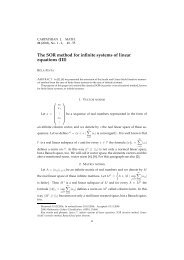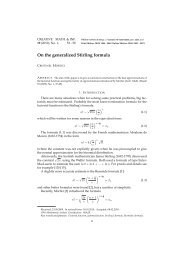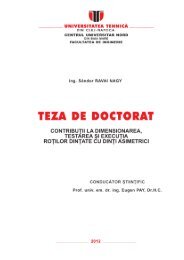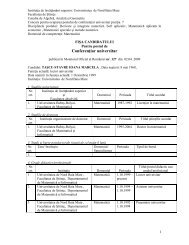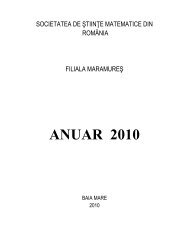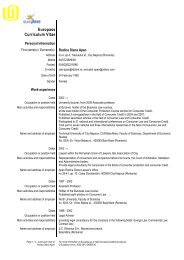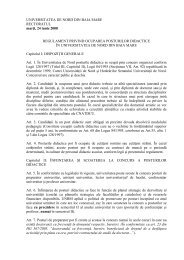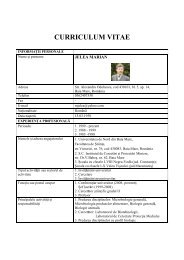Vol 3 (1) 2011 - UBM :: Departamentul de Chimie-Biologie
Vol 3 (1) 2011 - UBM :: Departamentul de Chimie-Biologie
Vol 3 (1) 2011 - UBM :: Departamentul de Chimie-Biologie
Create successful ePaper yourself
Turn your PDF publications into a flip-book with our unique Google optimized e-Paper software.
Y. Vagelas , M. Zold, L. Giurgiulescu, Study on Tokaj Wine contamination with different type of moulds<br />
STUDY ON TOKAJ WINE CONTAMINATION WITH<br />
DIFFERENT TYPE OF MOULDS<br />
Vagelas Yannis 1* , Maria Zold 2 , Liviu Giurgiulescu 2<br />
1<br />
Technological Institute of Larissa, TEI, Departament of Crop Protection and Plant<br />
Pathology, Larissa, Greece, *vagelas@teilar.gr<br />
2 North University of Baia Mare, Science Faculty, Chemistry-Biology Departament,<br />
Victoriei Street, No. 76, Baia Mare, Romania<br />
ABSTRACT<br />
Wine is and it will be one of the most consumed alcoholic drinks, both for its unique taste and its health<br />
benefits. Throughout time scientist had tried to stop as much as possible wine contamination, especially<br />
microorganism from the corks. Moulds are those that <strong>de</strong>velop into the greatest extend and may be dangerous to<br />
humans, causing allergic reactions or respiratory problems.This paper shows the effect that different types of mold<br />
have on the Tokaj white wines, in terms of composition characteristics.<br />
Keywords: fungi, wine, contamination, Penicillium expansum, microscope picture, magnetic stirrer.<br />
1. Introduction<br />
Even nowadays technology is advancing<br />
at lightning speed, microorganism wine<br />
contamination is not exclu<strong>de</strong>d. One of the<br />
actual problems that wine industry faces is<br />
wine contamination with microorganism<br />
from the corks. The purpose of this paper is<br />
to follow the Tokaj white wine<br />
contamination with three different types of<br />
fungi. The types of wine are: Dry Furmint,<br />
Aszú 4 putony, Sweet Szamorodni [1, 2].<br />
Fungi were isolated from samples<br />
obtained from contaminated cork<br />
(corkwood) stoppers. Three types of isolated<br />
fungi were used: Penicillium chrysogenum,<br />
Penicillium expansum, Phanerochaete<br />
chrysosporium (Figures 1, 2, 3) [3].<br />
The i<strong>de</strong>ntification of the above fungi<br />
were ma<strong>de</strong> on the basis of their macroscopic<br />
(cultural and morphological characters on<br />
agar medium) and microscopic structures:<br />
the formed of individual conidia the chains<br />
of conidia, the structure and types of<br />
conidiophores.<br />
2. Materials and methods<br />
2.1 Materials<br />
Three types of wine was used for<br />
experiment <strong>de</strong>velopment: (i) Dry Furmint;<br />
(ii) Sweet Szamorodni and (iii) Aszu 4<br />
putony.<br />
2.2 Methods<br />
Each type of wine was divi<strong>de</strong>d in four<br />
Erlenmayes glasses, obraining twelve<br />
samples. Three samples were preserved<br />
intact and the remaining samples were<br />
inoculated with the three types of mold.<br />
Then the glasses were agitated for three<br />
weeks on the magnetic stirrer (Figures 4, 5).<br />
The goal was to obtain from each type of<br />
wine a healthy sample, the second with<br />
Penicillium chrysogenum, the third with<br />
Penicillium expansium and the fourth with<br />
Phanerochaete chrysosporium.<br />
Microorganisms were isolated from<br />
damaged cork samples, plated fragments<br />
into PDA plates (potatoes <strong>de</strong>xtrose agar).<br />
57



